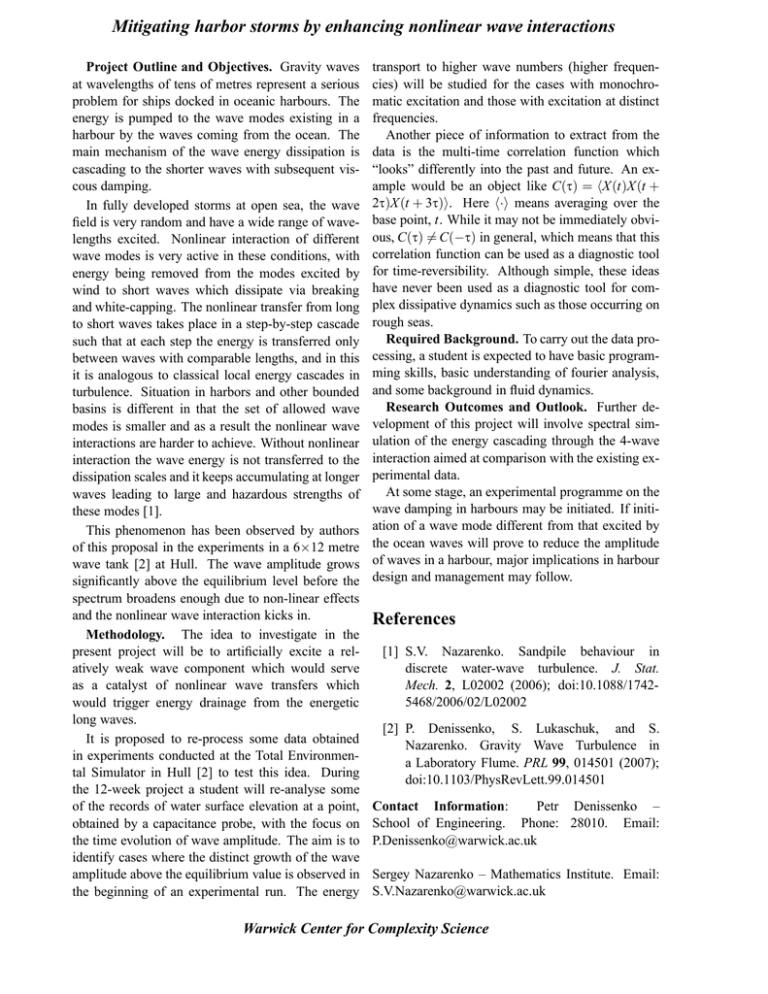Mitigating harbor storms by enhancing nonlinear wave interactions
advertisement

Mitigating harbor storms by enhancing nonlinear wave interactions Project Outline and Objectives. Gravity waves at wavelengths of tens of metres represent a serious problem for ships docked in oceanic harbours. The energy is pumped to the wave modes existing in a harbour by the waves coming from the ocean. The main mechanism of the wave energy dissipation is cascading to the shorter waves with subsequent viscous damping. In fully developed storms at open sea, the wave field is very random and have a wide range of wavelengths excited. Nonlinear interaction of different wave modes is very active in these conditions, with energy being removed from the modes excited by wind to short waves which dissipate via breaking and white-capping. The nonlinear transfer from long to short waves takes place in a step-by-step cascade such that at each step the energy is transferred only between waves with comparable lengths, and in this it is analogous to classical local energy cascades in turbulence. Situation in harbors and other bounded basins is different in that the set of allowed wave modes is smaller and as a result the nonlinear wave interactions are harder to achieve. Without nonlinear interaction the wave energy is not transferred to the dissipation scales and it keeps accumulating at longer waves leading to large and hazardous strengths of these modes [1]. This phenomenon has been observed by authors of this proposal in the experiments in a 6×12 metre wave tank [2] at Hull. The wave amplitude grows significantly above the equilibrium level before the spectrum broadens enough due to non-linear effects and the nonlinear wave interaction kicks in. Methodology. The idea to investigate in the present project will be to artificially excite a relatively weak wave component which would serve as a catalyst of nonlinear wave transfers which would trigger energy drainage from the energetic long waves. It is proposed to re-process some data obtained in experiments conducted at the Total Environmental Simulator in Hull [2] to test this idea. During the 12-week project a student will re-analyse some of the records of water surface elevation at a point, obtained by a capacitance probe, with the focus on the time evolution of wave amplitude. The aim is to identify cases where the distinct growth of the wave amplitude above the equilibrium value is observed in the beginning of an experimental run. The energy transport to higher wave numbers (higher frequencies) will be studied for the cases with monochromatic excitation and those with excitation at distinct frequencies. Another piece of information to extract from the data is the multi-time correlation function which “looks” differently into the past and future. An example would be an object like C(τ) = hX (t)X (t + 2τ)X (t + 3τ)i. Here h·i means averaging over the base point, t. While it may not be immediately obvious, C(τ) 6= C(−τ) in general, which means that this correlation function can be used as a diagnostic tool for time-reversibility. Although simple, these ideas have never been used as a diagnostic tool for complex dissipative dynamics such as those occurring on rough seas. Required Background. To carry out the data processing, a student is expected to have basic programming skills, basic understanding of fourier analysis, and some background in fluid dynamics. Research Outcomes and Outlook. Further development of this project will involve spectral simulation of the energy cascading through the 4-wave interaction aimed at comparison with the existing experimental data. At some stage, an experimental programme on the wave damping in harbours may be initiated. If initiation of a wave mode different from that excited by the ocean waves will prove to reduce the amplitude of waves in a harbour, major implications in harbour design and management may follow. References [1] S.V. Nazarenko. Sandpile behaviour in discrete water-wave turbulence. J. Stat. Mech. 2, L02002 (2006); doi:10.1088/17425468/2006/02/L02002 [2] P. Denissenko, S. Lukaschuk, and S. Nazarenko. Gravity Wave Turbulence in a Laboratory Flume. PRL 99, 014501 (2007); doi:10.1103/PhysRevLett.99.014501 Contact Information: Petr Denissenko – School of Engineering. Phone: 28010. Email: P.Denissenko@warwick.ac.uk Sergey Nazarenko – Mathematics Institute. Email: S.V.Nazarenko@warwick.ac.uk Warwick Center for Complexity Science





